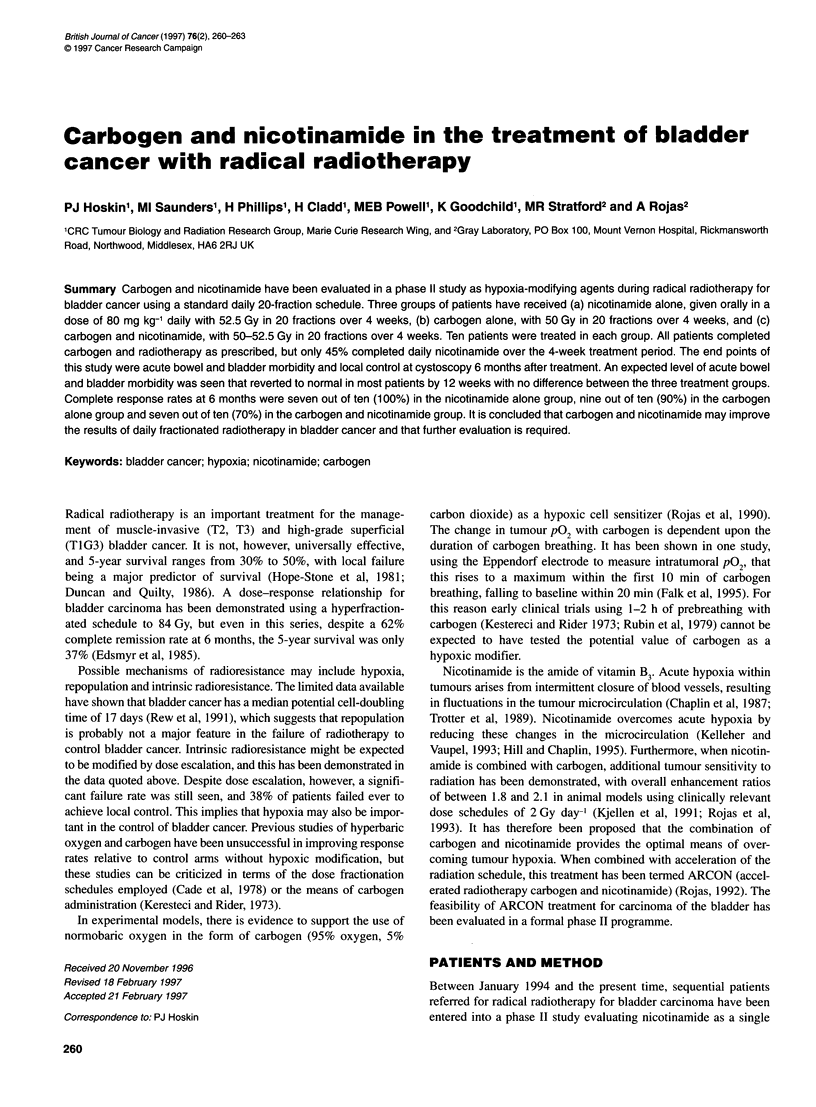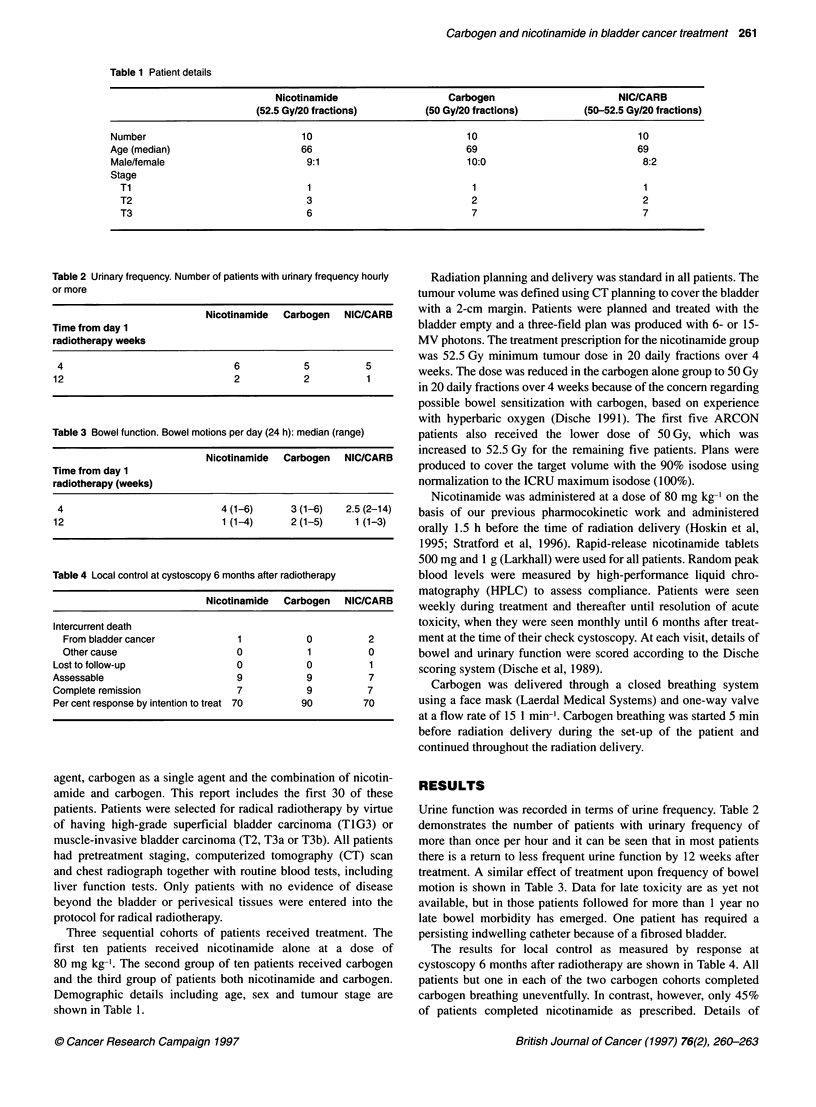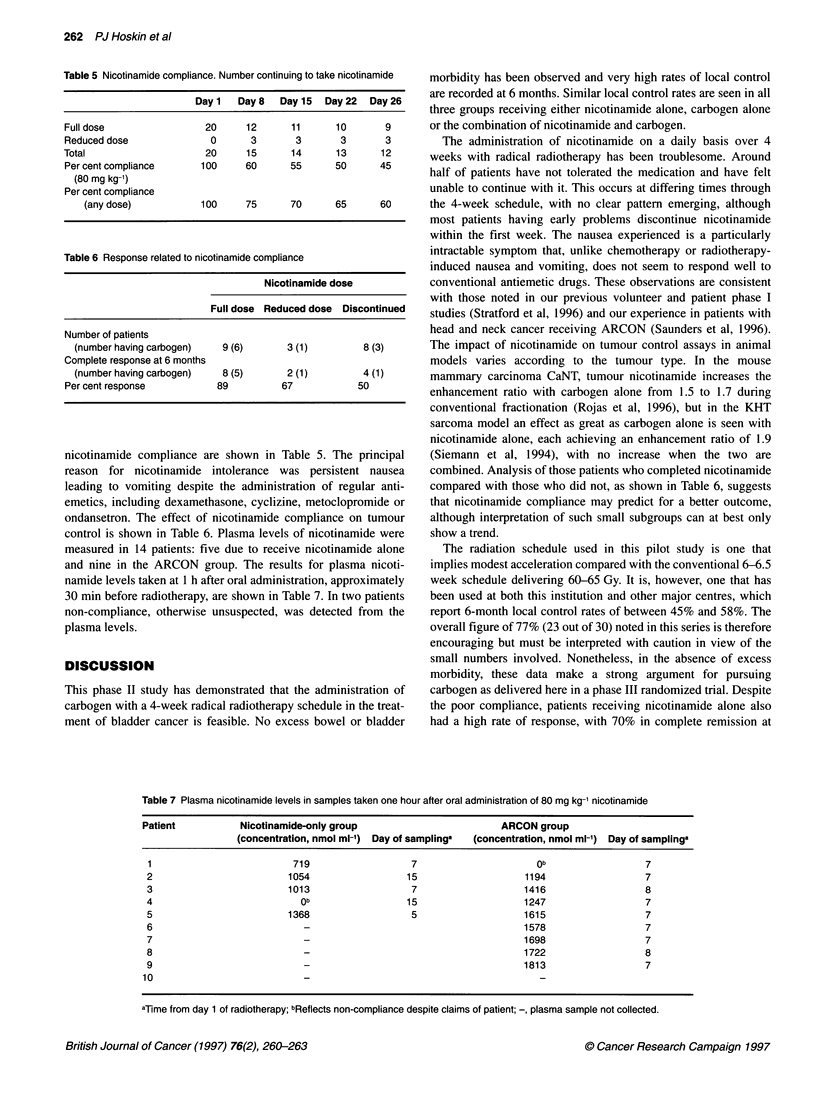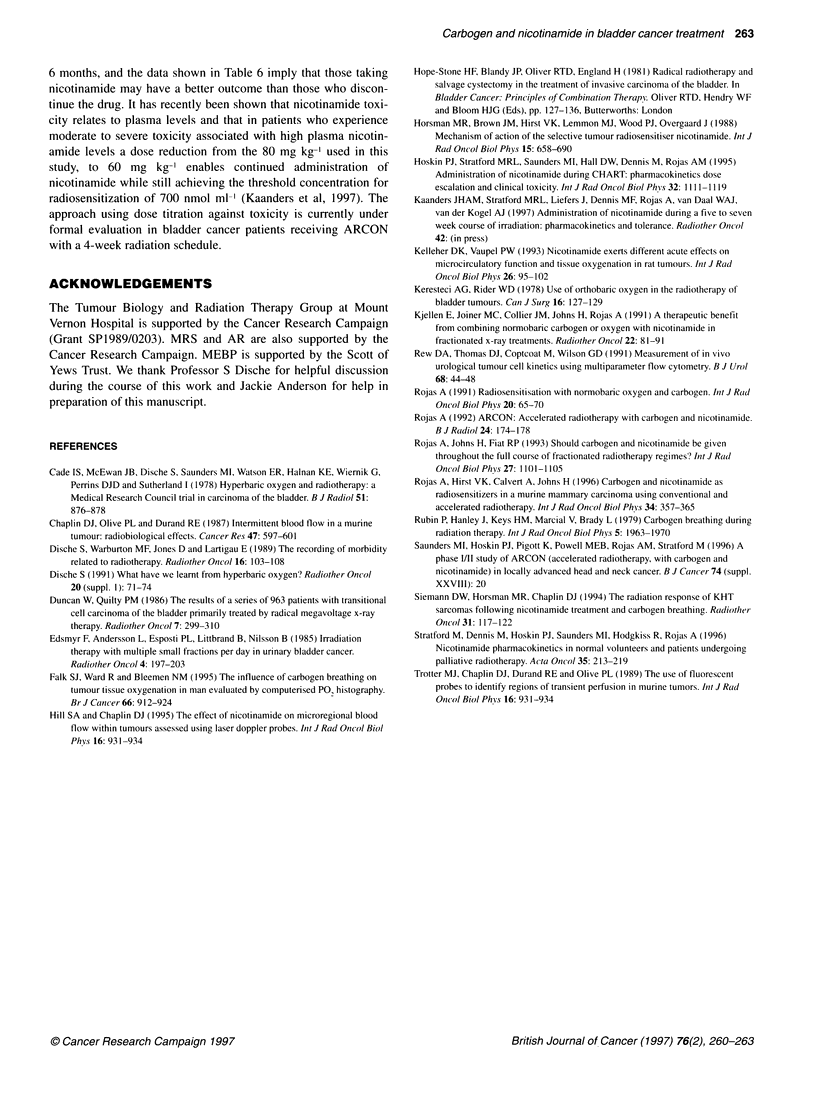Abstract
Carbogen and nicotinamide have been evaluated in a phase II study as hypoxia-modifying agents during radical radiotherapy for bladder cancer using a standard daily 20-fraction schedule. Three groups of patients have received (a) nicotinamide alone, given orally in a dose of 80 mg kg(-1) daily with 52.5 Gy in 20 fractions over 4 weeks, (b) carbogen alone, with 50 Gy in 20 fractions over 4 weeks, and (c) carbogen and nicotinamide, with 50-52.5 Gy in 20 fractions over 4 weeks. Ten patients were treated in each group. All patients completed carbogen and radiotherapy as prescribed, but only 45% completed daily nicotinamide over the 4-week treatment period. The end points of this study were acute bowel and bladder morbidity and local control at cystoscopy 6 months after treatment. An expected level of acute bowel and bladder morbidity was seen that reverted to normal in most patients by 12 weeks with no difference between the three treatment groups. Complete response rates at 6 months were seven out of ten (100%) in the nicotinamide alone group, nine out of ten (90%) in the carbogen alone group and seven out of ten (70%) in the carbogen and nicotinamide group. It is concluded that carbogen and nicotinamide may improve the results of daily fractionated radiotherapy in bladder cancer and that further evaluation is required.
Full text
PDF



Selected References
These references are in PubMed. This may not be the complete list of references from this article.
- Cade I. S., McEwen J. B., Dische S., Saunders M. I., Watson E. R., Halnan K. E., Wiernik G., Perrins D. J., Sutherland I. Hyperbaric oxygen and radiotherapy: a Medical Research Council trial in carcinoma of the bladder. Br J Radiol. 1978 Nov;51(611):876–878. doi: 10.1259/0007-1285-51-611-876. [DOI] [PubMed] [Google Scholar]
- Chaplin D. J., Olive P. L., Durand R. E. Intermittent blood flow in a murine tumor: radiobiological effects. Cancer Res. 1987 Jan 15;47(2):597–601. [PubMed] [Google Scholar]
- Dische S., Warburton M. F., Jones D., Lartigau E. The recording of morbidity related to radiotherapy. Radiother Oncol. 1989 Oct;16(2):103–108. doi: 10.1016/0167-8140(89)90026-1. [DOI] [PubMed] [Google Scholar]
- Dische S. What have we learnt from hyperbaric oxygen? Radiother Oncol. 1991;20 (Suppl 1):71–74. doi: 10.1016/0167-8140(91)90191-i. [DOI] [PubMed] [Google Scholar]
- Duncan W., Quilty P. M. The results of a series of 963 patients with transitional cell carcinoma of the urinary bladder primarily treated by radical megavoltage X-ray therapy. Radiother Oncol. 1986 Dec;7(4):299–310. doi: 10.1016/s0167-8140(86)80059-7. [DOI] [PubMed] [Google Scholar]
- Edsmyr F., Andersson L., Esposti P. L., Littbrand B., Nilsson B. Irradiation therapy with multiple small fractions per day in urinary bladder cancer. Radiother Oncol. 1985 Nov;4(3):197–203. doi: 10.1016/s0167-8140(85)80084-0. [DOI] [PubMed] [Google Scholar]
- Falk S. J., Ward R., Bleehen N. M. The influence of carbogen breathing on tumour tissue oxygenation in man evaluated by computerised p02 histography. Br J Cancer. 1992 Nov;66(5):919–924. doi: 10.1038/bjc.1992.386. [DOI] [PMC free article] [PubMed] [Google Scholar]
- Horsman M. R., Brown J. M., Hirst V. K., Lemmon M. J., Wood P. J., Dunphy E. P., Overgaard J. Mechanism of action of the selective tumor radiosensitizer nicotinamide. Int J Radiat Oncol Biol Phys. 1988 Sep;15(3):685–690. doi: 10.1016/0360-3016(88)90312-4. [DOI] [PubMed] [Google Scholar]
- Hoskin P. J., Stratford M. R., Saunders M. I., Hall D. W., Dennis M. F., Rojas A. Administration of nicotinamide during chart: pharmacokinetics, dose escalation, and clinical toxicity. Int J Radiat Oncol Biol Phys. 1995 Jul 15;32(4):1111–1119. doi: 10.1016/0360-3016(95)00022-q. [DOI] [PubMed] [Google Scholar]
- Kelleher D. K., Vaupel P. W. Nicotinamide exerts different acute effects on microcirculatory function and tissue oxygenation in rat tumors. Int J Radiat Oncol Biol Phys. 1993 Apr 30;26(1):95–102. doi: 10.1016/0360-3016(93)90178-x. [DOI] [PubMed] [Google Scholar]
- Keresteci A. G., Rider W. D. Use of orthobaric oxygen in the radiotherapy of bladder tumours. Can J Surg. 1973 Mar;16(2):127–129. [PubMed] [Google Scholar]
- Kjellen E., Joiner M. C., Collier J. M., Johns H., Rojas A. A therapeutic benefit from combining normobaric carbogen or oxygen with nicotinamide in fractionated X-ray treatments. Radiother Oncol. 1991 Oct;22(2):81–91. doi: 10.1016/0167-8140(91)90002-x. [DOI] [PubMed] [Google Scholar]
- Rew D. A., Thomas D. J., Coptcoat M., Wilson G. D. Measurement of in vivo urological tumour cell kinetics using multiparameter flow cytometry. Preliminary study. Br J Urol. 1991 Jul;68(1):44–48. doi: 10.1111/j.1464-410x.1991.tb15255.x. [DOI] [PubMed] [Google Scholar]
- Rojas A. M., Johns H., Fiat P. R. Should carbogen and nicotinamide be given throughout the full course of fractionated radiotherapy regimens? Int J Radiat Oncol Biol Phys. 1993 Dec 1;27(5):1101–1105. doi: 10.1016/0360-3016(93)90530-9. [DOI] [PubMed] [Google Scholar]
- Rojas A. ARCON: accelerated radiotherapy with carbogen and nicotinamide. BJR Suppl. 1992;24:174–178. [PubMed] [Google Scholar]
- Rojas A., Hirst V. K., Calvert A. S., Johns H. Carbogen and nicotinamide as radiosensitizers in a murine mammary carcinoma using conventional and accelerated radiotherapy. Int J Radiat Oncol Biol Phys. 1996 Jan 15;34(2):357–365. doi: 10.1016/0360-3016(95)02087-x. [DOI] [PubMed] [Google Scholar]
- Rojas A. Radiosensitization with normobaric oxygen and carbogen. Radiother Oncol. 1991;20 (Suppl 1):65–70. doi: 10.1016/0167-8140(91)90190-r. [DOI] [PubMed] [Google Scholar]
- Rubin P., Hanley J., Keys H. M., Marcial V., Brady L. Carbogen breathing during radiation therapy-the Radiation Therapy Oncology Group Study. Int J Radiat Oncol Biol Phys. 1979 Nov-Dec;5(11-12):1963–1970. doi: 10.1016/0360-3016(79)90946-5. [DOI] [PubMed] [Google Scholar]
- Siemann D. W., Horsman M. R., Chaplin D. J. The radiation response of KHT sarcomas following nicotinamide treatment and carbogen breathing. Radiother Oncol. 1994 May;31(2):117–122. doi: 10.1016/0167-8140(94)90391-3. [DOI] [PubMed] [Google Scholar]
- Stratford M. R., Dennis M. F., Hoskin P. J., Saunders M. I., Hodgkiss R. J., Rojas A. Nicotinamide pharmacokinetics in normal volunteers and patients undergoing palliative radiotherapy. Acta Oncol. 1996;35(2):213–219. doi: 10.3109/02841869609098504. [DOI] [PubMed] [Google Scholar]
- Trotter M. J., Chaplin D. J., Durand R. E., Olive P. L. The use of fluorescent probes to identify regions of transient perfusion in murine tumors. Int J Radiat Oncol Biol Phys. 1989 Apr;16(4):931–934. doi: 10.1016/0360-3016(89)90889-4. [DOI] [PubMed] [Google Scholar]


